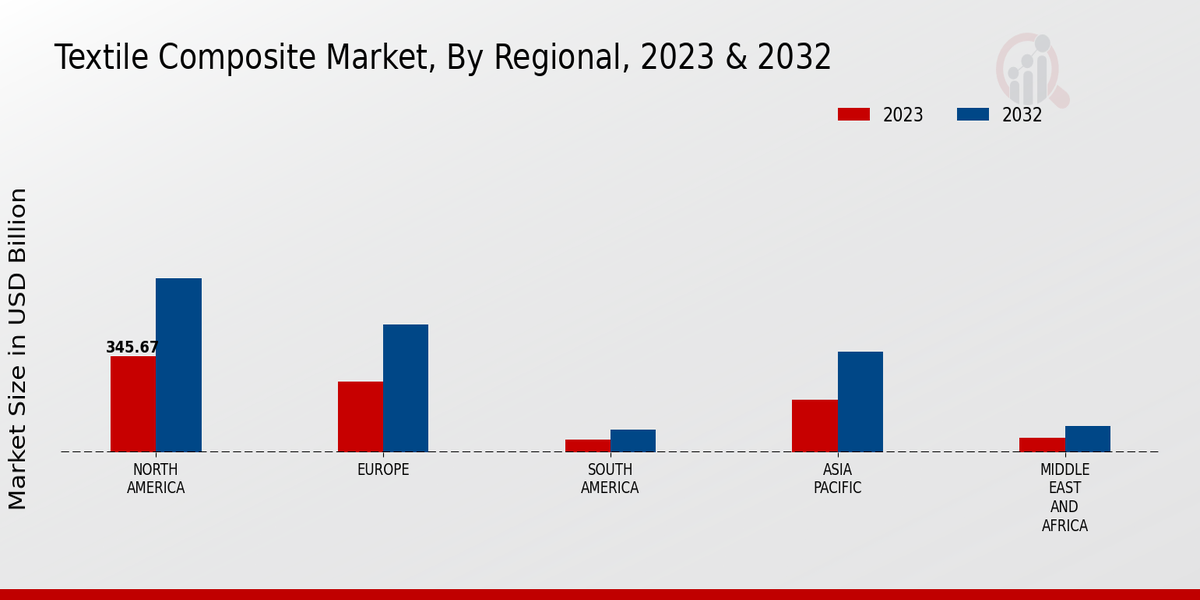Global Textile Composite Market Overview
The Textile Composite Market Size was estimated at 999.47(USD Billion) in 2024. The Textile Composite Industry is expected to grow from 1,062.56(USD Billion) in 2025 to 1,843.30(USD Billion) by 2034. The Textile Composite Market CAGR (growth rate) is expected to be around 6.30% during the forecast period (2025 - 2034).
Key Textile Composite Market Trends Highlighted
The Textile Composite Market is experiencing notable advancements, driven by increasing demand for lightweight, durable, and sustainable materials across various industries. Key drivers fueling growth include the rising adoption of composites in the automotive, aerospace, and construction sectors. Opportunities for expansion lie in the exploration of advanced manufacturing technologies and the development of eco-friendly textile composites.
Recent trends in the market include the integration of smart textiles, the use of 3D printing for complex composite structures, and the emergence of bio-based composites. These advancements are expected to drive market growth and create new avenues for innovation. Additionally, the increasing emphasis on reducing carbon footprint and promoting sustainability is driving demand for textile composites in various industries.

Source: Primary Research, Secondary Research, MRFR Database and Analyst Review
Textile Composite Market Drivers
Growing Demand for Lightweight and Durable Materials
The textile composite market is primarily driven by the increasing demand for lightweight and durable materials in various industries, including automotive, aerospace, and construction. These materials offer a unique combination of strength, flexibility, and weight reduction, making them ideal for applications where performance and efficiency are critical. The growing adoption of composite materials in these industries is expected to drive significant growth in the textile composite market over the forecast period.
Advancements in Fiber Technology
The textile composite market is also driven by advancements in fiber technology. The development of new and innovative fibers with improved properties, such as high strength, modulus, and toughness, is enhancing the performance of textile composites. These advanced fibers enable the production of lightweight and durable composites that meet the demanding requirements of various applications. The continuous research and development in fiber technology is expected to further contribute to the growth of the Textile Composite Market Industry.
Increasing Adoption in Emerging Economies
The growing demand for textile composites in emerging economies is another key driver of the market. Rapid industrialization and urbanization in these regions are leading to increased infrastructure development, transportation, and manufacturing activities. This, in turn, is driving the demand for lightweight and durable materials, such as textile composites, in these emerging markets. The increasing investment in infrastructure and manufacturing sectors in these regions is expected to provide significant growth opportunities for the Textile Composite Market Industry.
Textile Composite Market Segment Insights
Textile Composite Market Fiber Type Insights
The market growth is attributed to the increasing demand for lightweight and high-performance materials in various industries, including automotive, aerospace, and construction. Fiber type is a key segmentation factor in the textile composite market. The major fiber types used in textile composites include carbon fiber, glass fiber, aramid fiber, and basalt fiber. Each fiber type offers unique properties that cater to specific application requirements. Carbon fiber is a high-strength, lightweight fiber that provides excellent stiffness and thermal stability.
It is widely used in high-performance applications, such as aerospace components, racing cars, and sporting goods. The carbon fiber market is estimated to reach USD 528.512 billion by 2023, and USD 910.292 billion by 2032, driven by the growing demand from the automotive and aerospace industries. Glass fiber is a versatile and cost-effective fiber that offers good strength and insulation properties. It is commonly used in construction applications, such as fiberglass insulation, roofing, and pipes. The glass fiber market is projected to reach USD 270.701 billion by 2023 and USD 461.381 billion by 2032, owing to its increasing adoption in the construction and automotive sectors.
Aramid fiber is a high-strength, heat-resistant fiber that is known for its flame-retardant properties. It is primarily used in protective clothing, automotive components, and aerospace applications. The aramid fiber market is anticipated to reach USD 59.296 billion by 2023 and USD 112.228 billion by 2032, driven by the growing demand for lightweight and protective materials in various industries. Basalt fiber is a natural fiber that offers high strength and thermal insulation properties. It is gaining popularity in construction applications, such as reinforcing concrete and insulation materials.
The basalt fiber market is expected to reach USD 25.781 billion by 2023 and USD 49.879 billion by 2032, owing to its increasing adoption in the construction and automotive industries. The choice of fiber type in textile composites depends on the specific application requirements and performance criteria. Carbon fiber is preferred for high-performance applications, while glass fiber is more suitable for cost-sensitive applications. Aramid fiber is ideal for protective applications, and basalt fiber is gaining popularity in construction applications.

Source: Primary Research, Secondary Research, MRFR Database and Analyst Review
Textile Composite Market Resin Type Insights
The Textile Composite Market is segmented by Resin Type into Epoxy Resin, Polyester Resin, Vinyl Ester Resin, and Phenolic Resin. Among these, Epoxy Resin is expected to dominate the market with a significant market share in 2023 due to its superior mechanical properties, high strength-to-weight ratio, and excellent chemical resistance. Polyester Resin is anticipated to hold the second-largest share, owing to its cost-effectiveness and versatility in various applications. Vinyl Ester Resin is projected to witness steady growth, driven by its high corrosion resistance and flame retardant properties.
Phenolic Resin is expected to account for a smaller share due to its limited applications compared to other resin types. The Textile Composite Market revenue is projected to reach USD 1533.54 billion by 2032, exhibiting a CAGR of 6.31% during the forecast period. This growth can be attributed to the increasing demand for lightweight and durable materials in various industries, such as automotive, aerospace, and construction. The growing adoption of textile composites in advanced applications, including wind turbine blades and ballistic protection, is further fueling market expansion.
The market is also witnessing the emergence of bio-based and sustainable textile composites driven by environmental concerns and regulations.
Textile Composite Market Manufacturing Process Insights
The Textile Composite Market is segmented by Manufacturing Process into Hand Lay-up, Automated Fiber Placement, Resin Transfer Molding, and Pultrusion. In 2023, the Hand Lay-up segment is expected to account for the largest share of the market, followed by Automated Fiber Placement, Resin Transfer Molding, and Pultrusion. Hand Lay-up is a widely used manufacturing process due to its simplicity and cost-effectiveness. Automated Fiber Placement offers high precision and repeatability, making it suitable for complex shapes and high-volume production.
Resin Transfer Molding provides an excellent surface finish and is used for producing large and complex parts. Pultrusion is a continuous process that produces constant cross-section profiles with high strength and stiffness. The Textile Composite Manufacturing Process market is expected to witness significant growth in the coming years, driven by the increasing adoption of composite materials in various applications.
Textile Composite Market Application Insights
The Textile Composite Market is segmented by Application into Automotive, Aerospace, Marine, Sports and Leisure, and Construction. The Automotive segment is expected to hold the largest share of the market in 2023, owing to the increasing demand for lightweight and fuel-efficient vehicles. The Aerospace segment is also expected to witness significant growth due to the rising demand for composite materials in aircraft manufacturing. The Marine segment is expected to grow steadily over the forecast period due to the increasing use of composite materials in boat and ship hulls.
The Sports and Leisure segment is also expected to witness growth due to the rising popularity of composite materials in sports equipment. The Construction segment is expected to grow at a moderate pace due to the increasing use of composite materials in building and infrastructure projects.
Textile Composite Market End-User Industry Insights
The end-user industry segment plays a crucial role in shaping the dynamics of the Textile Composite Market. Key end-user industries include the automotive, aerospace, marine, construction, and sports equipment industries. In the automotive industry, textile composites are gaining traction due to their lightweight and high-strength properties, which enhance fuel efficiency and reduce emissions. The growing demand for lightweight vehicles and the increasing adoption of electric vehicles are expected to drive the growth of this segment in the coming years.
The aerospace industry is another major end-user of textile composites, where they are utilized for aircraft components such as wings, fuselages, and interiors. The demand for lightweight and durable materials in the aerospace industry is propelling the growth of this segment. The marine industry is also witnessing increased adoption of textile composites, particularly in boat hulls, decks, and other structural components. The use of composites in marine applications offers advantages such as enhanced durability, corrosion resistance, and weight reduction.
In the construction industry, textile composites are employed in roofing, cladding, and reinforcement applications. Their lightweight and high-strength properties make them suitable for various construction projects, leading to the growth of this segment. The sports equipment industry is another key end-user of textile composites. The use of composites in sports equipment, such as tennis rackets, golf clubs, and bicycle frames, provides benefits like improved performance, durability, and weight reduction.
Textile Composite Market Regional Insights
The Textile Composite Market is segmented into North America, Europe, APAC, South America, and MEA. North America is the largest market for textile composites, followed by Europe. The APAC region is expected to witness the highest growth over the forecast period. North America Market size: USD 345.67 billion in 2023 Growth rate: 6.5% CAGR Key drivers: Growing demand for lightweight and durable materials in the automotive and aerospace industries Europe Market size: USD 254.32 billion in 2023 Growth rate: 6.1% CAGR Key drivers: Strong presence of automotive and aerospace industries, government regulations promoting sustainability APAC Market size: USD 189.45 billion in 2023 Growth rate: 7.2% CAGR Key drivers: Rapid urbanization, growing population, and increasing disposable income South America Market size: USD 45.23 billion in 2023 Growth rate: 5.8% CAGR Key drivers: Growing demand for textile composites in the construction and infrastructure industries MEA Market size: USD 50.62 billion in 2023 Growth rate: 6.7% CAGR Key drivers: Increasing investments in infrastructure and construction projects, government initiatives promoting industrialization.

Source: Primary Research, Secondary Research, MRFR Database and Analyst Review
Textile Composite Market Key Players And Competitive Insights:
Major players in the Textile Composite Market industry are constantly striving to gain a competitive edge by investing in research and development, expanding their product portfolios, and enhancing their manufacturing capabilities. Leading Textile Composite Market players are focusing on developing innovative solutions to meet the evolving needs of end-users. They are also adopting strategic partnerships and collaborations to strengthen their market position. The Textile Composite Market development is driven by factors such as growing demand for lightweight and high-performance materials, increasing adoption of composites in various industries, and government initiatives to promote sustainability. The Textile Composite Market Competitive Landscape is expected to remain highly competitive in the coming years, with key players focusing on differentiation through innovation and strategic alliances.
Saint-Gobain is a leading company in the Textile Composite Market. The company offers a wide range of textile composites for various applications, including automotive, aerospace, construction, and wind energy. Saint-Gobain's commitment to innovation has resulted in the development of advanced materials and technologies, such as reinforcement fabrics, prepregs, and laminates. The company has a presence and serves customers worldwide.
Another major player in the Textile Composite Market is Toray Industries. The company is known for its high-performance fibers and composites used in a variety of industries, including automotive, aerospace, and electronics. Toray's dedication to research and development has led to the creation of innovative materials, such as carbon fiber composites and thermoplastic composites. The company has a reach and operates manufacturing facilities in multiple countries.
Key Companies in the Textile Composite Market Include:
Textile Composite Market Industry Developments
Rising demand for lightweight, durable, and high-performance materials in industries such as automotive, aerospace, and construction is driving market growth.
Recent developments include the emergence of sustainable and bio-based textile composites, increasing adoption of wearable technology and smart textiles, and advancements in manufacturing processes like resin transfer molding and automated fiber placement. Key players are investing in research and development to enhance product offerings and cater to evolving customer needs. Strategic partnerships and acquisitions are shaping the competitive landscape, with companies seeking to expand their market presence and gain technological advantages.
Textile Composite Market Segmentation Insights
-
Textile Composite Market Fiber Type Outlook
-
Carbon Fiber
-
Glass Fiber
-
Aramid Fiber
-
Basalt Fiber
-
Textile Composite Market Resin Type Outlook
-
Epoxy Resin
-
Polyester Resin
-
Vinyl Ester Resin
-
Phenolic Resin
-
Textile Composite Market Manufacturing Process Outlook
-
Hand Lay-up
-
Automated Fiber Placement
-
Resin Transfer Molding
-
Pultrusion
-
Textile Composite Market Application Outlook
-
Automotive
-
Aerospace
-
Marine
-
Sports and Leisure
-
Construction
-
Textile Composite Market End-User Industry Outlook
-
Automotive Industry
-
Aerospace Industry
-
Marine Industry
-
Construction Industry
-
Sports Equipment Industry
-
Textile Composite Market Regional Outlook
-
North America
-
Europe
-
South America
-
Asia Pacific
-
Middle East and Africa
| Report Attribute/Metric |
Details |
| Market Size 2024 |
999.47(USD Billion) |
| Market Size 2025 |
1,062.56(USD Billion) |
| Market Size 2034 |
1,843.30(USD Billion) |
| Compound Annual Growth Rate (CAGR) |
6.30% (2025 - 2034) |
| Report Coverage |
Revenue Forecast, Competitive Landscape, Growth Factors, and Trends |
| Base Year |
2024 |
| Market Forecast Period |
2025 - 2034 |
| Historical Data |
2020 - 2024 |
| Market Forecast Units |
USD Billion |
| Key Companies Profiled |
Gurit, Dow, Cytec Industries, Lanxess, Owens Corning, Teijin, DuPont, SGL Carbon, Mitsubishi Chemical, Zoltek, Hexcel, BASF, 3B the fiberglass company, Toray Industries |
| Segments Covered |
Fiber Type, Resin Type, Manufacturing Process, Application, End-User Industry, Regional |
| Key Market Opportunities |
Advanced lightweight materials Growing demand in aerospace Increased use in automotive Sports and recreation applications Emerging applications in construction |
| Key Market Dynamics |
Increasing demand from automotive aerospace and construction Government initiatives for sustainable materials Technological advancements in fiber and resin production Growing popularity of lightweight and durable materials Rising awareness of environmental concerns |
| Countries Covered |
North America, Europe, APAC, South America, MEA |
Frequently Asked Questions (FAQ) :
The textile composite market was valued at USD 1,062.56 billion in 2025 and is projected to grow at a CAGR of 6.30% from 2025 to 2034, reaching USD 1,843.30 billion by 2034.
North America is expected to hold the largest market share in the textile composite market, accounting for over 45% of the market in 2023.
The growing demand for lightweight and high-performance materials in various industries, such as automotive, aerospace, and construction, is a key factor driving the growth of the textile composite market.
The automotive and aerospace applications are expected to witness the highest growth in the textile composite market, owing to the increasing demand for lightweight and fuel-efficient vehicles and aircraft.
Key competitors in the textile composite market include Toray Industries, Teijin Limited, Hexcel Corporation, SGL Carbon, and Mitsubishi Chemical Corporation.
The textile composite market is projected to grow at a CAGR of 6.30% from 2025 to 2034.
The automotive industry is expected to account for the largest share of the textile composite market in 2032, owing to the increasing demand for lightweight and high-performance materials in vehicle manufacturing.
Major trends shaping the textile composite market include the development of new and innovative materials, the increasing adoption of automated manufacturing processes, and the growing focus on sustainability.
Challenges faced by the textile composite market include the high cost of raw materials, the complex manufacturing processes, and the stringent regulatory requirements.
Technological advancements, such as the development of new materials and automated manufacturing processes, are expected to have a positive impact on the textile composite market by improving product performance and reducing production costs.

















